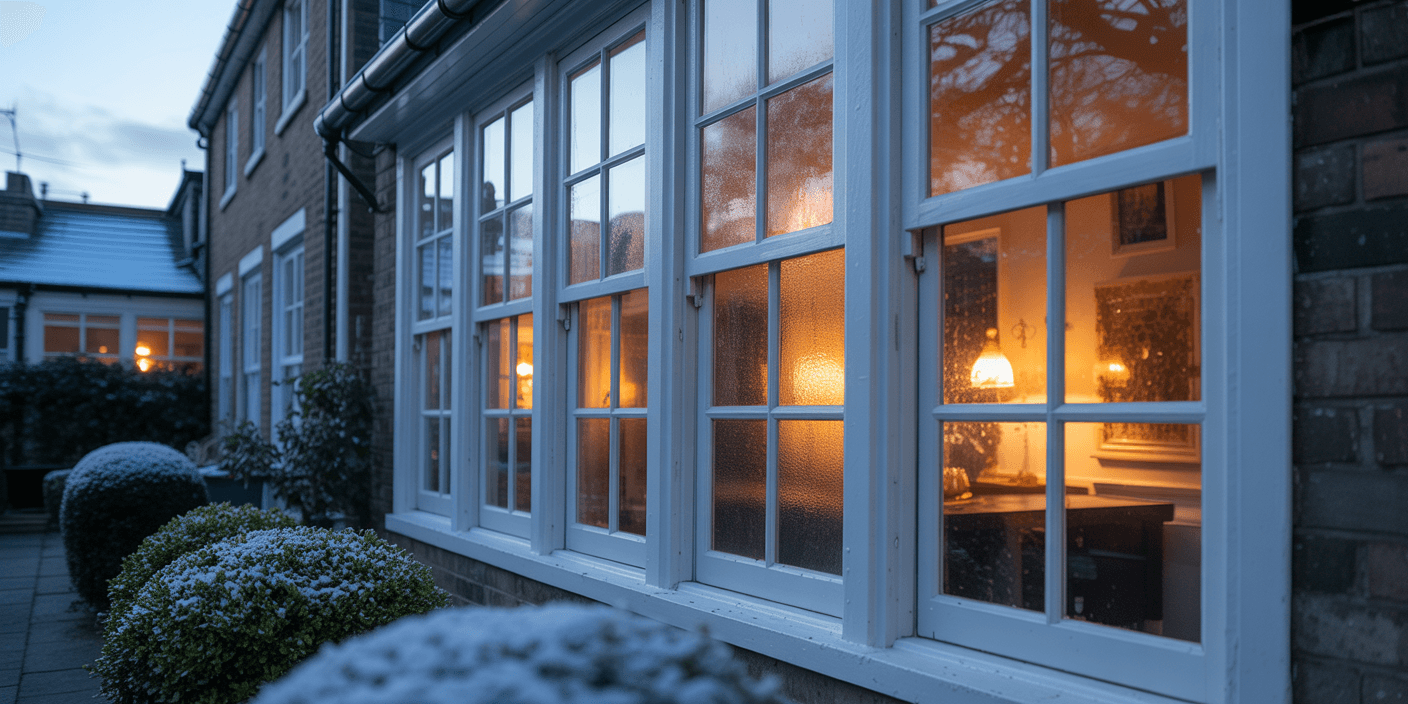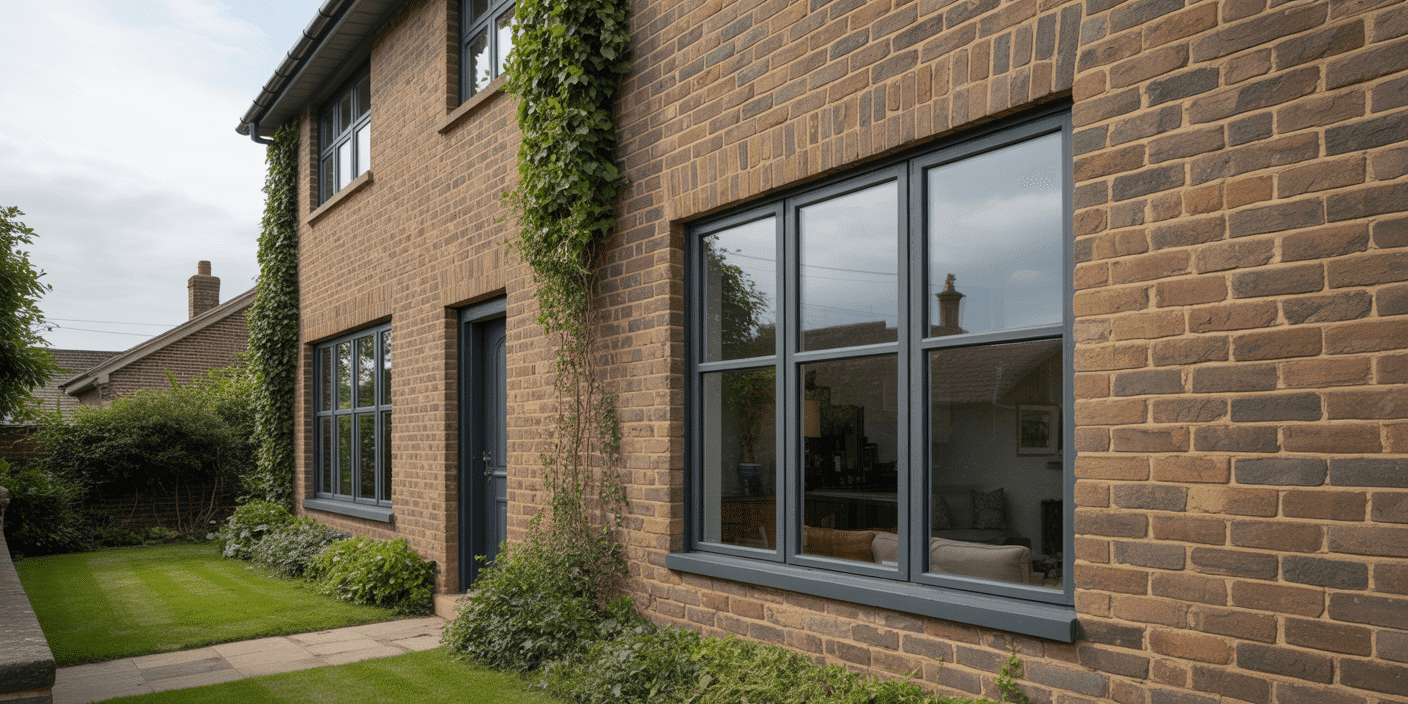The Overlooked Number Costing British Homeowners Thousands
Each winter, homes across the UK quietly lose substantial amounts of heat—without a sound, without a trace.
This loss is not always due to poor insulation or an inefficient boiler. In fact, up to 25% of a home’s heat can escape through its windows—a figure that continues to rise in properties fitted with outdated or underperforming glazing.
The key to understanding this hidden loss lies in a single measurement:
The U-value.
A window’s U-value reflects its thermal efficiency—specifically, how well it prevents heat from escaping. The lower the number, the better the performance. Under current UK regulations, any new or replacement window must achieve a U-value of 1.4 W/m²·K or lower to comply with Part L of the Building Regulations.
Yet many window suppliers either omit this figure entirely or provide misleading “centre-pane” values that fail to represent the window’s actual performance. Customers are left vulnerable to higher energy bills, failed inspections, and legal non-compliance.
In response, a select group of specialists are setting a higher standard—designing window systems that combine architectural authenticity with certified thermal performance.
Among them, Sash Windows London stands as a leading authority—trusted by conservation officers, architects, and discerning homeowners alike to deliver solutions that are beautiful, compliant, and measurably effective.
U-Value: The Window’s Report Card
A U-value isn’t marketing jargon. It’s a hard measurement of how quickly heat slips out of your home through a building element — your walls, your roof, and most critically, your windows.
It’s expressed in watts per square metre per Kelvin (W/m²·K). Don’t worry about the physics. What matters is this:
The lower the U-value, the better your window is at keeping heat inside.
Think of it as a leak score. A window with a U-value of 5.0 is a gaping hole. A window at 1.4 is regulation-ready. At 1.0 or below, you’re in Passive House territory — a home so efficient it almost heats itself.
Here’s the reality across Britain’s housing stock:
- Single glazing: Around 5.0 W/m²·K — like heating the street.
- Old double glazing: 2.5 W/m²·K — better, but still bleeding heat.
- Modern double glazing: 1.4 W/m²·K — just meets Part L.
- Triple glazing: 0.8–1.2 W/m²·K — high-performance living.
It’s not just about the glass either. Frames, seals and spacers all count towards your whole-window U-value — the only number Building Control cares about.
And this is where Sash Windows London quietly excels. Our timber and composite systems aren’t just beautiful; they’re engineered to deliver whole-window U-values of 1.4 and below without changing the character of your home. You get the elegance you expect and the performance the law demands — in one frame.
The Misleading Figure Salespeople Love

Here’s a truth most window companies won’t tell you:
The U-value they quote is often just for the glass — not the whole window.
Why does that matter? Because what you’re paying for, and what the law requires, is whole-window performance. That includes the frame, glazing, spacer bars, seals, and the way they’re assembled. If a company sells you a beautiful “1.1 U-value” but that figure is just for the centre of the glass, you’re being misled — and potentially left non-compliant.
Let’s break it down:
- Glass U-value: Measures heat loss only through the pane, under perfect lab conditions.
- Whole-window U-value: Measures heat loss through the entire unit, as it performs in the real world.
It’s the second one that counts — especially under Part L of UK Building Regulations, which now mandates whole-unit performance figures. If your installer can’t prove that, your building inspector can fail the job. And your energy bills? They’ll tell the story soon enough.
Unfortunately, most off-the-shelf systems are still quoting glass-only U-values, especially at the budget end of the market. They sound good — until you look at the fine print. Or worse, until you get a knockback at final inspection.
This is exactly why Sash Windows London insists on certified whole-window U-values for every system we supply — and why we document those numbers before the first screw goes in. We don’t sell numbers. We deliver performance.
Because when it comes to insulation, precision isn’t optional. It’s the law.
The Law Has Changed: Part L and Your Liability
You might think choosing windows is just a design or budget decision. It’s not.
In the UK, it’s a legal matter — and the law isn’t vague.
Since the 2022 update to Part L of the Building Regulations, every new or replacement window in England must meet a whole-window U-value of 1.4 W/m²·K or lower. No exceptions. Whether you’re fitting out a new build, upgrading a flat in a Victorian terrace, or retrofitting a Georgian townhouse in a conservation area, the rule applies.
Fall short, and you face more than just a chilly living room:
- Failed inspections that delay build timelines and drive up costs
- Legal exposure if the work doesn’t meet the regulations
- Reduced EPC ratings, impacting mortgage options and resale value
- Insurability risks, especially on listed or high-value properties
And if you think Building Control is lax — think again. Local authorities are under pressure to enforce the rules rigorously as part of the UK’s net zero strategy.
That’s why Part L compliance isn’t just about ticking a box. It’s about risk mitigation, asset value protection, and future-proofing your property for a market that increasingly punishes inefficiency.
Sash Windows London doesn’t just claim compliance. We build it in. Our systems are independently tested to meet and exceed Part L — with full certification supplied before installation.
So when the inspector arrives, there’s no last-minute panic. Just a signature, a smile, and a warm home that passed the test.
It’s Not Just About Energy. It’s About Comfort, Value and Future-Proofing.
When homeowners hear “U-value,” they think: energy bills. And yes—better insulation can save hundreds of pounds a year. But the true impact of high-performance windows goes far deeper than your quarterly statement.
Comfort You Can Feel
Low U-value windows create a steady indoor temperature—no more icy draughts by the sill or overheated rooms in summer. The glass is warmer to the touch. The frames don’t radiate cold. The home feels better because it holds the warmth you’ve paid for.
Quiet, You Didn’t Expect
While U-value and acoustic performance are different metrics, there’s an overlap. The same layered, sealed, gas-filled technologies that slow heat loss also block outside noise. Especially in timber sash systems, a well-built low-U-value window is surprisingly quiet—ideal for homes near roads, schools, or the city.
Asset Protection
Today’s buyers are savvier than ever. Poor thermal performance isn’t just uncomfortable—it’s measurable. EPC ratings impact mortgage approvals, letability, and resale price. A window with a U-value over 1.4 in 2025 is tomorrow’s liability. One at 1.2 or below? That’s future-proofing.
Heritage With Integrity
If your home is in a conservation area, you know the challenge: modern standards vs period charm. Fortunately, with the right materials and detailing, you no longer have to choose. Timber sash windows can now hit U-values once reserved for clunky PVC units—without a single compromise on heritage detail.
This is the quiet power of precision joinery and modern glazing science.
This is the warmth, value, and comfort that Sash Windows London designs into every frame.
Yes, Period Homes Can Have Passive-Level Performance

There’s a stubborn myth that refuses to die:
“You can’t make heritage windows energy efficient without ruining the look.”
Not true. Not anymore.
Thanks to advances in timber window engineering, high-performance sash and casement systems can now reach whole-window U-values of 1.2 and below—all while complying with conservation guidelines and preserving period authenticity.
At Sash Windows London, we’ve spent years perfecting the intersection of traditional British craftsmanship and modern thermal science. Here’s how it works:
Timber, Refined
We use engineered hardwoods and Accoya—stable, durable, low-maintenance materials with excellent insulating properties. No warping. No rot. Just solid, honest, high-performance joinery.
Glass That Works Harder
Double or triple glazing with warm-edge spacers, argon or krypton gas fills, and low-emissivity coatings. The kind of glass that retains heat like a thermos flask, not a leaky pane.
Precision Build Quality
Where cheap frames rely on silicone and sales chat, we rely on tolerances and truth. A well-made sash window doesn’t just look right—it seals properly, locks tightly, and resists thermal bridging. That’s how you earn U-values under 1.4 without PVC or compromise.
Design That Respects the Street
Slim sightlines, putty-effect glazing, traditional horns, and authentic mouldings. Conservation officers approve. Neighbours admire. Only the warmth stays silent.
We’ve helped Georgian terraces in Kensington, Victorian villas in Clapham, and listed townhouses in Richmond achieve modern performance behind traditional facades. The result: warm, quiet, efficient homes that still look like they belong on a postcard.
Performance is no longer the enemy of beauty.
In the right hands, it’s the perfect finishing touch.
Five Questions Every Homeowner Should Demand Answers To
Most window quotes sound the same—until it’s too late.
That’s why informed homeowners don’t just ask for prices. They ask the right questions.
Before you commit to a window supplier, run this checklist. If they can’t answer with confidence, clarity, and evidence—walk away.
1. “Is that U-value for the whole window, or just the glass?”
If the answer is “just the glass,” you’re being misled.
Only whole-window U-values matter under Part L of UK Building Regulations. Sash Windows London certifies all systems at the full unit level—frame, glass, spacer, seal and all.
2. “Can you prove compliance with Part L, Part Q, and Part K?”
These aren’t suggestions. They’re legal minimums.
From thermal performance (Part L), to security (Part Q), to safety glazing (Part K), we engineer every window to pass the full inspection suite—with documentation in hand.
3. “Will this design be approved in a conservation area?”
Many suppliers say yes—until your planning officer says no.
We work within the rules of heritage planning every day, using authentic materials, period-correct profiles, and slimline glazing systems that meet both aesthetic and performance standards.
4. “What’s the U-value target for this property type?”
Different projects require different standards. A Passive House spec isn’t the same as a standard refit. But too many firms treat them the same.
We tailor window specs to the build context, whether it’s a Victorian terrace, a new-build in Wandsworth, or a listed mews house in Camden.
5. “What’s your failure rate at final inspection?”
If they can’t answer this, that is the answer.
We back every system with performance data before it’s installed—so you know your windows won’t just look right… They’ll be signed off first time.
Sash Windows London isn’t just here to supply windows.
We’re here to make sure you never lose sleep over them.
From Confusion to Confidence: Book Your U-Value Window Assessment Today
By now, you understand what most don’t:
✅ The U-value tells you how much heat your windows lose
✅ Whole-window U-values are what Building Control cares about
✅ Part L, Part Q, and Part K are non-negotiable
✅ Most suppliers are still quoting outdated or misleading figures
✅ You don’t have to compromise heritage charm for high performance
And yet, most homeowners will still go with a glossy brochure and a friendly price—only to end up with cold rooms, failed inspections, and a property that doesn’t meet modern expectations.
You won’t be one of them.
Because you now know what to ask, what to avoid, and what great looks and performs like.
At Sash Windows London, we specialise in windows that pass inspection the first time, lower your energy bills, and look as beautiful in Kensington as they do in Kent.
Whether you’re restoring a listed townhouse, remodelling a family home, or building something from the ground up, we’ll help you choose windows that are:
- Certified to 1.4 U-value or better
- Fully compliant with all Building Regs
- Custom-crafted to suit period or contemporary styles
- Installed with precision by qualified specialists
Ready to get it right the first time?
👉 Book your free U-Value & Compliance Window Assessment
👉 Download our Part L Compliance Spec Sheet
👉 See our latest high-performance window case studies
You’re not buying glass. You’re protecting your home, your warmth, your money—and your peace of mind.
Let’s get started.







